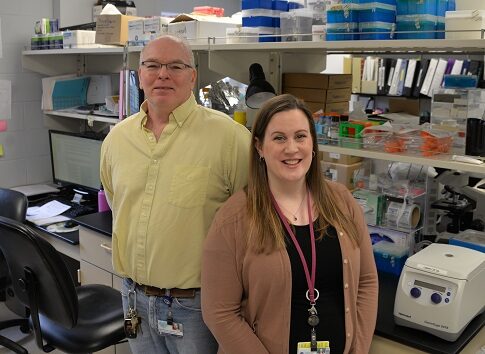NIH Awards $3.8M Grant to Advance Development of Tularemia Vaccine

Scientists at Albany Medical College have been awarded a five-year, $3.8 million grant from the National Institutes of Health (NIH) to test the efficacy of a new potential vaccine for tularemia, a rare but potentially fatal disease.
Caused by the bacterium Francisella tularensis (Ft), tularemia is most commonly found in rabbits and similar animals in rural areas. According to the CDC, humans can be infected through tick and deer fly bites, skin contact with infected animals, drinking contaminated water, or inhaling contaminated aerosols. There is concern that a sophisticated laboratory could manufacture it as a bioweapon and it’s listed as a Tier 1, Category A bioterrorism agent.
Tularemia is currently treated with antibiotics, although engineered antibiotic-resistant strains of the Francisella bacterium are a concern. A previous live vaccine strain vaccine (LVS) developed in the 1950s failed to provide acceptable protection in humans, and is not FDA-licensed for general use in the U.S.
Bacteriologist Karsten Hazlett, PhD, professor in the Department of Regenerative and Cancer Cell Biology, is heading the study on this new vaccine candidate in collaboration with fellow principal investigators Eileen Barry, PhD, of the University of Maryland School of Medicine, who created the vaccine, and Douglas Reed, PhD, of the University of Pittsburgh Center for Vaccine Research, an immunologist and aerobiologist.
The team will use their combined expertise in bacteriology, vaccinology, aerobiology, and biostatistics to expand their research that previously identified a vaccine that was highly effective in mouse and rabbit models.
“In this final step before human clinical trials, we hope to show our vaccine to be just as effective in non-human primate models,” said Dr. Hazlett.
In addition, the researchers will compare the biomarkers identified in response to their vaccine with biomarkers seen in human plasma samples from people who had been vaccinated with the live vaccine strain as part of the U.S. Army’s Special Immunization Program.
“This head-to-head comparison will provide critical data about our vaccine candidate and, if it performs as we expect, will support advancement of this vaccine and set the stage for a phase 1 clinical trial,” said Dr. Hazlett.
Titled, “Translation of a highly protective tularemia vaccine to the NHP model,” the study is funded by the NIH’s National Institute of Allergy and Infectious Diseases.
